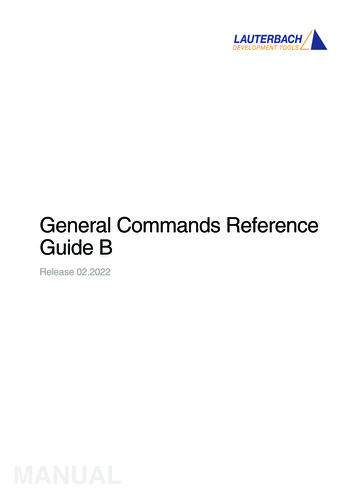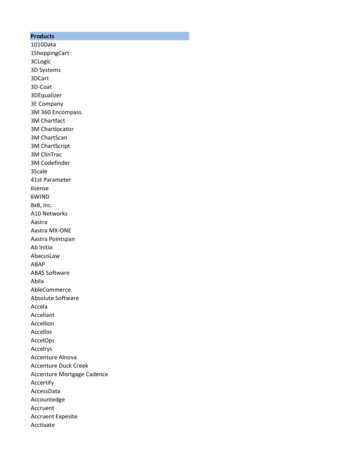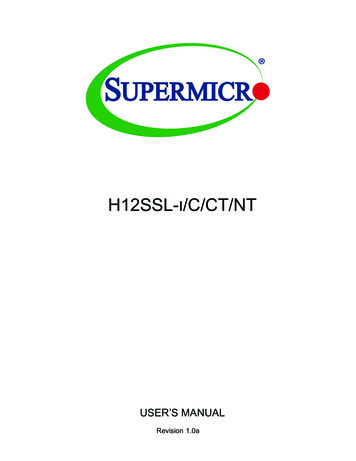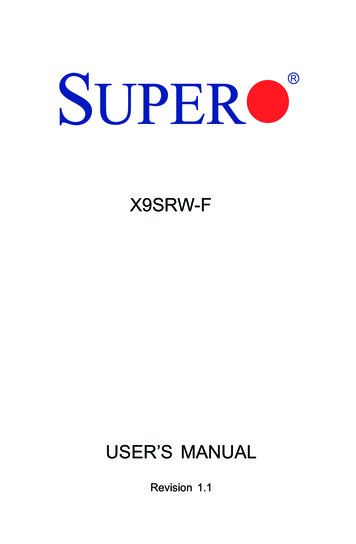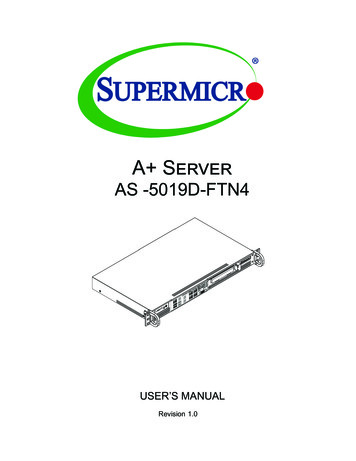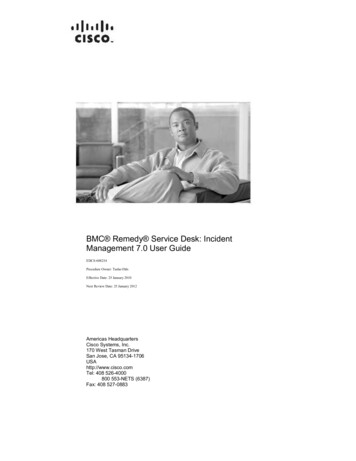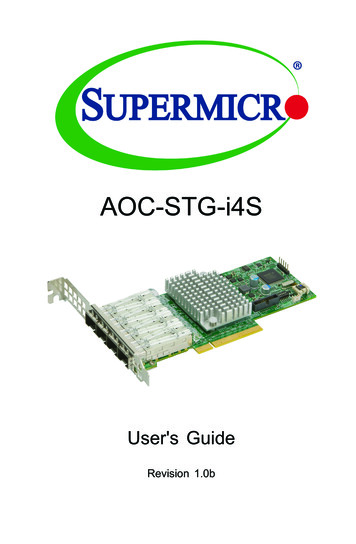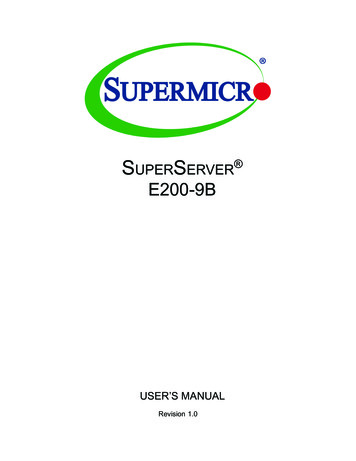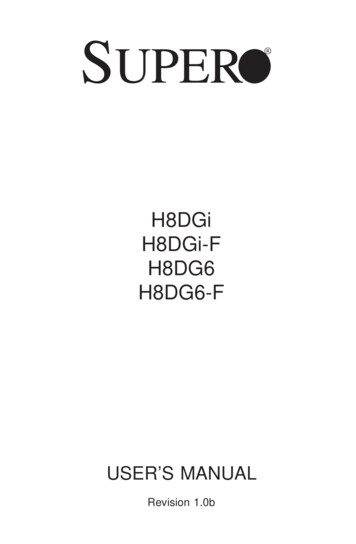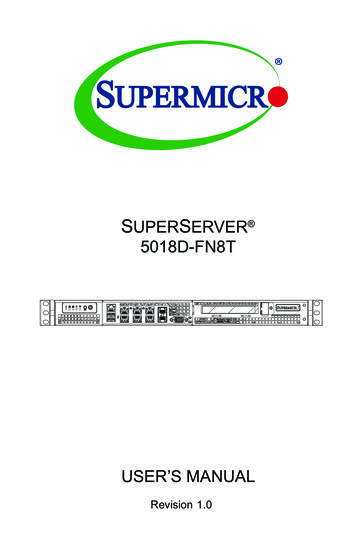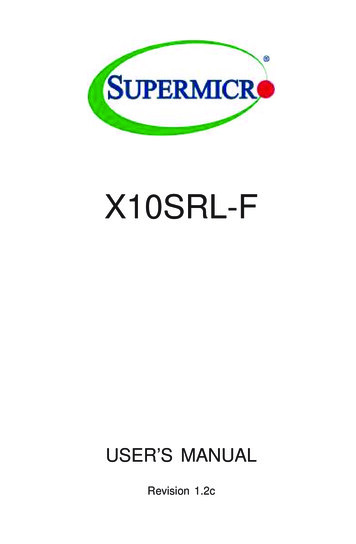
Transcription
FEATURE GUIDEExecutive SummaryTABLE OF CONTENTSExecutive Summary. . . . . . . . . . . . . . . . . . . . . . . . . . . . . . . . . . . . . . . . . . . . 1Configure BMC Network Settings with Security . . . . . . . . . . . . . . . . 1Secure Redfish APIs . . . . . . . . . . . . . . . . . . . . . . . . . . . . . . . . . . . . . . . . . . . . 6BIOS-BMC secure features . . . . . . . . . . . . . . . . . . . . . . . . . . . . . . . . . . . . . 6Hardware Security . . . . . . . . . . . . . . . . . . . . . . . . . . . . . . . . . . . . . . . . . . . . . 7Principles of Secure Software Development Life cycle.7Signed firmware and Right Tools from Supermicro . . . . . . . . . . . . 8Conclusion.8SUPERMICROSupermicro is a global leader in high performance, high efficiencyserver technology and innovation that develops and provides endto-end green computing solutions to the datacenter, cloudcomputing, enterprise IT, big data, HPC, and embedded markets.Our Building Block Solutions approach allows us to build andprovide a broad range of SKUs that are optimized to individualcustomer needs and workloads.Copyright 2022 Super Micro Computer, Inc. All rights reservedSupermicro server architecture is built on advancedtechnologies that provide high performance/watt, flexible IO,and management features that allow Enterprises/datacenters/OEMs to achieve the best ROI for their business. One of thesetechnologies is the onboard baseboard management controller(BMC), which provides an efficient interface that enables ITadministrators to manage the server's health rmaintenance tasks like BIOS upgrades and debug OS remotelythrough KVM consoles.Configure BMC Network Settings with Security onSupermicro ServersWhile this feature increases convenience and productivity,server administrators need to understand that BMCs areembedded controllers with an operating system and networkstack that could be vulnerable to attacks if not configuredcorrectly. This feature guide provides several practical use casesfor the user to figure out how proper BMC configurations canmitigate vulnerability attacks.May 20221
IP Address AssignmentDHCP is the default protocol for receiving IP addresses. However, administrators are encouraged to set static IP addresses orrestrict the assignment of DHCP addresses to a secure set of IP addresses or subnet.LAN AccessThe BMC can be accessed through either a dedicated Ethernet LAN interface (if available) or through a shared LAN (SystemLAN) Interface. The default setting is ‘failover,’ which means the BMC will first check for the presence of an active, dedicatedLAN interface, other it will respond on through a shared LAN interface. The failover setting helps IT administrators receivedefault connectivity to the BMC, irrespective of their network topology and provision systems remotely. It is recommendedthat administrators configure BMCs LAN access through a dedicated LAN interface instead of a System LAN. The BMC is notexposed to the internet or unauthorized user access outside of a firewall.While the IPMI standard protocol defines UDP port 623 for RMCP communications, there are additional remote services thatBMCs provide to efficiently provision and debug servers. Some of these services include VNC for debugging an OS, access tohttp/https ports for BMC settings and reading server health, and Virtual media for remotely accessing files and images.Note: Unhooking an Ethernet cable from a dedicated LAN interface does not stop accessing BMCs from a shared LAN interface.Service PortsAll these services run on TCP/UDP ports (please see the security feature guide for the latest information), and it is important torestrict these ports to secure the server management network. Alternatively, the administrator can reconfigure the portnumbers or disable unused services to avoid unnecessary security exposure on BMCs. For example, http can be configured tolisten on port 76680 such that attackers cannot find the servers through common port scanning tools.Copyright 2022 Super Micro Computer, Inc. All rights reservedMay 20222
RAKPIPMI standard dictates using the RAKP protocol to authenticate RMCP sessions between IPMI clients and BMC servers. Thecurrent RAKP hash is typically weak, meaning that one can use brute methods to retrieve passwords. The Supermicro BMCprovides a stronger hash option for RAKP authentication. Since this is an OEM implementation and may not be suitable inevery environment, administrators still recommend blocking UDP port 623 on unsecured networks.IP Access ControlsBMC access should be restricted to include only known machine IP Addresses. This eliminates unwarranted access tocorporate servers from inside the network accidentally or deliberately.VLAN ConfigurationsConfigure traffic from BMCs to IPMI clients on a unique VLAN so that management traffic can be segregated from the rest ofthe server data.Copyright 2022 Super Micro Computer, Inc. All rights reservedMay 20223
Configuring the BMC NetworkThough BMCs provide security features to defend against unwarranted attacks, it is strongly recommended thatadministrators follow the best practice of configuring BMCs on the networks where they are locally accessible and restricttraffic on sensitive ports between networks. Traffic on default ports for BMCs such as TCP/5900 and UDP/ 623 should berestricted to secure and known networks using firewall rules in routers.BMC management account securitySupermicro BMC provides the following two secure functions to enhance BMC user accounts security and protect fromexcessive failed login attempts:1.Authentication failure lockout controlsWhen user authentication fails, the Supermicro BMC solution can notify the user about the logging fault threshold and denythe user further login authentication, even with the correct password. In addition, the frequency of event logs, the number offailed attempts, and the time for the lockout to expire can be adjusted via the BMC web user interface.2.Password complexity and value rulesSupermicro BMC solution secures each user account with password complexity, preventing hackers from easily orsystematically cracking the user account password. As a result, either IT administrators or ordinary users can enjoy a securedremote management environment provided by the Supermicro BMC solution.Password SecuritySupermicro BMC solution equips every Supermicro product with a preprogrammed BMC management password, which isunique. It requires a user to generate a new means of authentication before access is granted to the device for the first time.This security mechanism can secure customers to have a more secure management environment afterward. Moreimportantly, it can comply with SB-327 law (California Law). Otherwise, Special characters like #, are not allowed into thepassword field, as these characters can enable shell injection from intruders. Instead, use strong passwords that are at leasteight characters long and include a mix of numbers, capital, and lower case letters.System LockdownSupermicro BMC solution can support the System Lockdown feature, and it offers IT administrators a secure way to preventunintentional system configuration changes. All system configuration changes, including firmware updates, are restrictedwhen system lockdown is enabled. As a result, the ordinary user only receives notifications when the IT administrator makes asystem configuration change. System lockdown can be configured by following Supermicro interfaces: Web GUI IPMI command Redfish BIOS GUI SUM (Supermicro Update Manager)Copyright 2022 Super Micro Computer, Inc. All rights reservedMay 20224
HTTPS for Web accessSupermicro BMC web server provides HTTPs connection by default to provide both IT administrators and ordinary users amore secure method to access runtime remote management data via the Supermicro BMC solution HTTPS uses the SSL/TLSprotocol to encrypt communications to avoid attackers stealing data. In addition, the Supermicro BMC solution containsSSL/TLS design, preventing impersonations and stopping multiple kinds of cyber attacks.SNMPv3Supermicro BMC solution also provides a more secure Simple Network Management Protocol Ver. 3(SNMPv3). The biggestsecurity concern in SNMPv1 and SNMPv2 is that community strings are sent as clear-text strings and not encrypted, whichmeans data transmission over SNMPv1 and SNMPv2 is not secure. This security concern has been fixed by SNMPv3 andensures community strings are always encrypted. IT Administrators can use SNMPv3 on the Supermicro BMC solution directlyto make your data center's network environment secure.KCS Privilege ControlSupermicro BMC solution also enhances the security of legacy IPMI in-band interface – KCS (Keyboard Controller Style). IPMIspec defines the privilege for IPMI Messaging Interface, but it is not applied to the KCS interface since it is a session-lessinterface. That causes the security issue. To secure the KCS interface, the Supermicro BMC solution offers enhanced featuresto secure your system inside.IT Administrators can configure KCS privileges by BMC Web and redfish API.Disallow In-band firmware updates over the KCS interfaceThis restriction is implemented in the latest Supermicro X12 platforms or later. Disable in-band firmware updates over the KCSinterface and only support in-band firmware updates through LAN/USB interface, which is much faster and more secure.Copyright 2022 Super Micro Computer, Inc. All rights reservedMay 20225
Detailed conventions:o Only Supermicro Update Manager (SUM) can update BIOS and BMC firmware through the BMC in-bandointerface3rd party tools (which are NOT validated by Supermicro) will not be allowed to work from Supermicro X12platformsSecure Redfish APIsSupermicro BMC solution also can support DMTF Redfish . A standard API delivers simple and secure management forconverged, hybrid IT and the Software Defined Data Center (SDDC). This modern interface builds on widely-used tools toaccelerate development. Today’s customers demand a well-defined API that uses the protocols, structures, and securitymodels common in Internet and web services environments.Secure In-band authentication through the Host interfaceFurthermore, the Supermicro BMC solution can support Redfish Host Interface Specification (DSP0270), providing BMC asecure communication channel to the host OS or UEFI.Main security features include: Support authentication, confidentiality, and integrity:o Support environments where users do not want to rely on Host/OS access control mechanisms solelyo Provide a mechanism to optionally (if configured) pass credentials to an OS Kernel for sensor monitoring(with configurable privilege) Support security requirements with authentication and confidentialityBIOS-BMC secure featuresSupermicro BMC solution can configure BIOS secure features, Secure Boot, and Secure Drive Erase via Redfish's secureinterface. As a result, IT administrators can take advantage of these two security features while provisioning or maintaining asystem. Secure BootSecure boot is part of the UEFI firmware standard (since 2.3.1c). A machine refuses to load any UEFI driver or app withsecure boot enabled unless the operating system bootloader is cryptographically signed. Secure Drive EraseIT administrators can apply an action to erase the disk connected with the Broadcom MegaRAID controller, and itallows IT administrators to render data on attached drives instantly and securely.Due to its secure data removal and cleansing, secure drive erase can comply with the most stringent privacy laws and meetthe most rigorous security requirements in the world as those set up by the State of California and the European Union.Copyright 2022 Super Micro Computer, Inc. All rights reservedMay 20226
Hardware SecurityAs security protections advance, attacks become increasingly sophisticated, including targeting the low-level platformfirmware, such as BIOS and BMC. Supermicro follows industry guidelines – NIST 800-193, Platform Firmware ResiliencyGuidelines, introduced by the National Institute of Standards and Technology (NIST) to design Firmware Resilient Platform. Aresilient firmware system begins with a platform Root-of-Trust(RoT). Supermicro RoT is a hardware-based solution thatprotects the various low-level platform firmware components from remote attacks. The protected duration includes eachsystem AC on, firmware update, and runtime. The key firmware components on the system, including BIOS, BMC, and CPLD,are all under RoT protection.Secure Firmware Updates and Restoration through RoTSupermicro RoT solution verifies the integrity of platform firmware images before the firmware is updated. And mostimportant, it can even restore corrupted firmware automatically from a protected known-good recovery image. It provides ITAdministrators additional options to protect low-level platform firmware with the Supermicro RoT solution.Runtime Protections through Trust Zone (TEE OS)Supermicro solution utilizes the Trust-Zone capability in BMC ARM processor to check the integrity of BMC applications andprocesses during runtime. Trust-Zone (TEE OS) provides an isolated processing environment in which Trusted Applicationscan be securely executed irrespective of the rest of the environment in BMC.Principles of Secure Software Development Life cycle to harden the firmware securitySupermicro solution is committed to taking our Software Development Life Cycle (SDLC) to the next level: the Secure SoftwareDevelopment Life Cycle (SSDLC). Considering the possible risk from a broad network connection scenario, we have enhancedour products and solutions during product development lifecycle management to provide appropriate features orconfigurations to IT Administrators for managing data centers with secured deployment. Supermicro has adopted thefollowing security practices in our development lifecycle framework: Inter-section Participants: different roles and duties regarding security development management were assigned tothe Developer, Software Security team, and Software Product Manager. Security Requirement and Risk Assessment: The requirements from relevant stakeholders and the risk frompossible applications must be evaluated while the product lifecycle is initiated. Security design and development analysis:o The open-source package for software was analyzed during the product development phase.o Threat modeling methodology was adopted for impact analysis.o An automatic tool such as a source code scanner, code repository, and issue tracking was applied for securecoding. Independent Security testing and validation:o Supermicro’s Software Security team has employed security testing with both static and dynamic analysiscriteria to discover known and unknown vulnerabilities. In addition, Supermicro has employed differenttesting tools regarding Vulnerability Scan, Penetration testing, and Fuzz testing.o When security issues with high priority are found, it is necessary to bring out the mitigations and then verifyby the Software Security team before product release. Issues with medium or low priority will be scheduledto fix according to the Supermicro development roadmap.Copyright 2022 Super Micro Computer, Inc. All rights reservedMay 20227
Security Deployment and Maintenance:o IT administrators for secured deployment should follow written network settings and system configurations.In addition, Supermicro has initialized a plan of firmware updates for our customers to respond to possiblevulnerabilities. Supermicro highly recommends that IT administrators follow a plan of a periodic firmwareupdate to avoid security issues.o Supermicro has initialized a public security center, where customers can report a security issue in time andupdate the status of responses regarding security issues.Moreover, Supermicro will keep monitoring the latest cybersecurity framework, such as Secure Software DevelopmentFramework (SSDF) and Cybersecurity Maturity Model Certification (CMMC), to fulfill different aspects of security requirementsregarding SSDLC.Signed firmware and Right Tools from SupermicroCryptographically signed firmwareSupermicro BMC, BIOS, motherboard CPLD, and Chassis Management Module's latest solutions use the CNSA algorithms torealize cryptographically signed firmware. Commercial National Security Algorithm (CNSA) Suite is published by the UnitedStates Government, which defines cryptographic algorithm policy for national security applications.Plan for periodic firmware updatesSupermicro releases periodic firmware updates that add new security features and provide fixes for issues on an ongoingbasis. In addition, Supermicro fixes high priority issues on its developed technologies and for many underlying componentsincluded in its products, such as OpenSSL.Hence, it is a collective responsibility of vendors and users of products to work together and ensure that the servers areupdated and secured in deployments.Please go to the Supermicro Security Center for the latest CVEs and information athttps://www.supermicro.com/en/support/security centerUsing the Right ToolsSupermicro provides several options to upgrade and provision BMC firmware depending on the server deployment size,environment (e.g., datacenter vs. an appliance in-network), operator’s choice of CLI or WebUI interfaces, etc.Some common tools available on the website are Supermicro Server Manager (SSM), Supermicro Update Manager (SUM),SMCIPMITOOL, IPMICFG, and IPMIView, which can all be downloaded from https://www.supermicro.com/smsConclusionSupermicro design continuously offers convenient, secure, and diversified remote management interfaces and methodsdesigned in our Baseboard Management Controllers (BMC) solution. It provides IT administers modern and efficient systemmanageability, including:Copyright 2022 Super Micro Computer, Inc. All rights reservedMay 20228
Web GUIIPMI commandRedfishSupermicro System Management Software (SSM, SUM etc.)Because of the BMC’s powerful capabilities, it is recommended that server administrators take advantage of the securityfeatures that BMCs offer while restricting network access to the BMC on a protected subnet behind a firewall. BMC Security isan evolving topic. Supermicro has been actively working with the IT security community and customers to provide timelyfirmware updates that continuously improve the security of Supermicro products. Supermicro recommends planning forregular firmware upgrades and employing the right set of tools to make upgrades and configurations easy.Copyright 2022 Super Micro Computer, Inc. All rights reservedMay 20229
Supermicro BMC solution also enhances the security of legacy IPMI in-band interface - KCS (Keyboard Controller Style). IPMI spec defines the privilege for IPMI Messaging Interface, but it is not applied to the KCS interface since it is a session-less interface. That causes the security issue.
